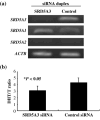Novel 5 alpha-steroid reductase (SRD5A3, type-3) is overexpressed in hormone-refractory prostate cancer
- PMID: 17986282
- PMCID: PMC11158902
- DOI: 10.1111/j.1349-7006.2007.00656.x
Novel 5 alpha-steroid reductase (SRD5A3, type-3) is overexpressed in hormone-refractory prostate cancer
Abstract
Prostate cancer often relapses during androgen-depletion therapy, even under conditions in which a drastic reduction of circulating androgens is observed. There is some evidence that androgens remain present in the tissues of hormone-refractory prostate cancers (HRPC), and enzymes involved in the androgen and steroid metabolic pathway are likely to be active in HRPC cells. We previously carried out a genome-wide gene expression profile analysis of clinical HRPC cells by means of cDNA microarrays in combination with microdissection of cancer cells and found dozens of transactivated genes. Among them, we here report the identification of a novel gene, SRD5A2L, encoding a putative 5 alpha-steroid reductase that produces the most potent androgen, 5 alpha-dihydrotestosterone (DHT), from testosterone. Liquid chromatography-tandem mass spectrometry analysis following an in vitro 5 alpha-steroid reductase reaction validated its ability to produce DHT from testosterone, similar to type 1 5 alpha-steroid reductase. Because two types of 5 alpha-steroid reductase were previously reported, we termed this novel 5 alpha-steroid reductase 'type 3 5 alpha-steroid reductase' (SRD5A3). Reverse transcription-polymerase chain reaction and northern blot analyses confirmed its overexpression in HRPC cells, and indicated no or little expression in normal adult organs. Knockdown of SRD5A3 expression by small interfering RNA in prostate cancer cells resulted in a significant decrease in DHT production and a drastic reduction in cell viability. These findings indicate that a novel type 3 5 alpha-steroid reductase, SRD5A3, is associated with DHT production and maintenance of androgen-androgen receptor-pathway activation in HRPC cells, and that this enzymatic activity should be a promising molecular target for prostate cancer therapy.
Figures




References
-
- Gronberg H. Prostate cancer epidemiology. Lancet 2003; 361: 859–64. - PubMed
-
- Hsing AW, Devesa SS. Trends and patterns of prostate cancer: what do they suggest? Epidemiol Rev 2001; 23: 3–13. - PubMed
-
- Feldman BJ, Feldman D. The development of androgen‐independent prostate cancer. Nat Rev Cancer 2001; 1: 34–45. - PubMed
-
- Han M, Partin AW, Piantadosi S et al . Era specific biochemical recurrence‐free survival following radical prostatectomy for clinically localized prostate cancer. J Urol 2001; 166: 416–19. - PubMed
-
- Petrylak DP, Tangen CM, Hussain MH et al . Docetaxel and estramustine compared with mitoxantrone and predonisone for advanced refractory prostate cancer. N Engl J Med 2004; 351: 1513–20. - PubMed
Publication types
MeSH terms
Substances
LinkOut - more resources
Full Text Sources
Other Literature Sources
Medical
Molecular Biology Databases

